HYUNDAI I10 2018 Workshop Manual
Manufacturer: HYUNDAI, Model Year: 2018, Model line: I10, Model: HYUNDAI I10 2018Pages: 343, PDF Size: 9.14 MB
Page 51 of 343

335
Safety system of your vehicle
What to expect after an air bag
inflates
After a frontal or side impact air bag
inflates, it will deflate very quickly. Air bag
inflation will not prevent the driver from see-
ing out of the windshield or being able to
steer. Curtain air bags may remain partially
inflated for some time after they deploy.
Noise and smoke from inflating air
bag
When the air bags inflate, they make a
loud noise and they leave smoke and
powder in the air inside of the vehicle.
This is normal and is a result of the igni-
tion of the air bag inflator. After the air
bag inflates, you may feel substantial dis-
comfort in breathing because of the con-
tact of your chest with both the seat belt
and the air bag, as well as from breathing
the smoke and powder. The powder may
aggravate asthma for some people. If you
experience breathing problems after an
air bag deployment, seek medical atten-
tion immediately.
Though the smoke and powder are non-
toxic, they may cause irritation to the
skin, eyes, nose, throat, etc. If this is the
case, wash and rinse with cold water
immediately and seek medical attention
if the symptoms persist.
Passenger’s front air bag
ON/OFF switch (if equipped)
The purpose of the switch is to disable
the passenger’s front air bag in order to
transport occupants who are at
increased risk for air bag-related injury
due to age, size, or medical condition.
WARNING
After an air bag inflates, take the
following precautions:
• Open your windows and doors as
soon as possible after impact to
reduce prolonged exposure to
the smoke and powder released
by the inflating air bag.
• Do not touch the air bag storage
area’s internal components
immediately after an air bag has
inflated. The parts that come into
contact with an inflating air bag
may be very hot.
• Always wash exposed skin areas
thoroughly with lukewarm water
and mild soap.
• We recommend that an author-
ized HYUNDAI dealer replace the
air bag immediately after deploy-
ment. Air bags are designed to be
used only once.
OIA0330033R
OIA0330033
■Left-hand drive
■Right-hand drive
Page 52 of 343
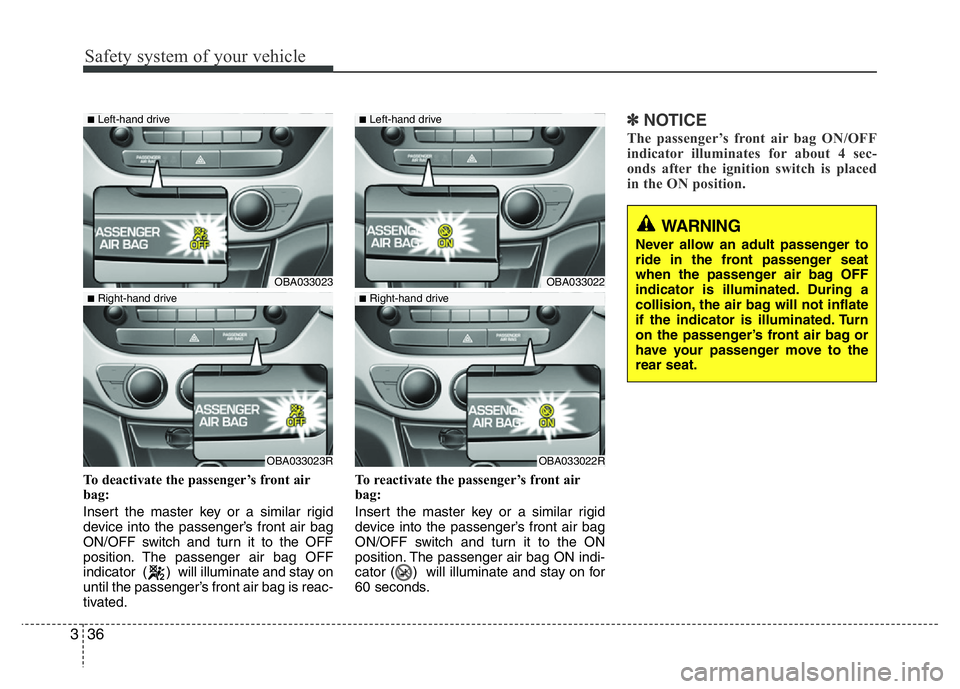
Safety system of your vehicle
36 3
To deactivate the passenger’s front air
bag:
Insert the master key or a similar rigid
device into the passenger’s front air bag
ON/OFF switch and turn it to the OFF
position. The passenger air bag OFF
indicator ( ) will illuminate and stay on
until the passenger’s front air bag is reac-
tivated.To reactivate the passenger’s front air
bag:
Insert the master key or a similar rigid
device into the passenger’s front air bag
ON/OFF switch and turn it to the ON
position. The passenger air bag ON indi-
cator ( ) will illuminate and stay on for
60 seconds.
✽NOTICE
The passenger’s front air bag ON/OFF
indicator illuminates for about 4 sec-
onds after the ignition switch is placed
in the ON position.
OBA033023OBA033022
OBA033023ROBA033022R
WARNING
Never allow an adult passenger to
ride in the front passenger seat
when the passenger air bag OFF
indicator is illuminated. During a
collision, the air bag will not inflate
if the indicator is illuminated. Turn
on the passenger’s front air bag or
have your passenger move to the
rear seat.
■Left-hand drive■Left-hand drive
■Right-hand drive■Right-hand drive
Page 53 of 343
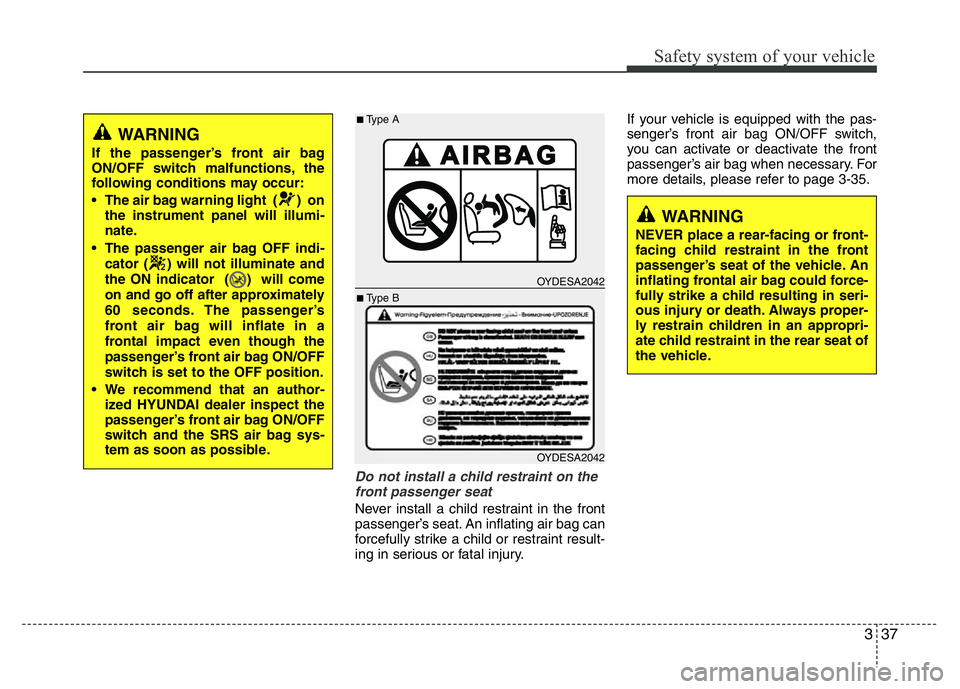
337
Safety system of your vehicle
Do not install a child restraint on the
front passenger seat
Never install a child restraint in the front
passenger’s seat. An inflating air bag can
forcefully strike a child or restraint result-
ing in serious or fatal injury.If your vehicle is equipped with the pas-
senger’s front air bag ON/OFF switch,
you can activate or deactivate the front
passenger’s air bag when necessary. For
more details, please refer to page 3-35.
WARNING
If the passenger’s front air bag
ON/OFF switch malfunctions, the
following conditions may occur:
• The air bag warning light ( ) on
the instrument panel will illumi-
nate.
• The passenger air bag OFF indi-
cator ( ) will not illuminate and
the ON indicator ( ) will come
on and go off after approximately
60 seconds. The passenger’s
front air bag will inflate in a
frontal impact even though the
passenger’s front air bag ON/OFF
switch is set to the OFF position.
• We recommend that an author-
ized HYUNDAI dealer inspect the
passenger’s front air bag ON/OFF
switch and the SRS air bag sys-
tem as soon as possible.
WARNING
NEVER place a rear-facing or front-
facing child restraint in the front
passenger’s seat of the vehicle. An
inflating frontal air bag could force-
fully strike a child resulting in seri-
ous injury or death. Always proper-
ly restrain children in an appropri-
ate child restraint in the rear seat of
the vehicle.
OYDESA2042
OYDESA2042
■Type A
■Type B
Page 54 of 343
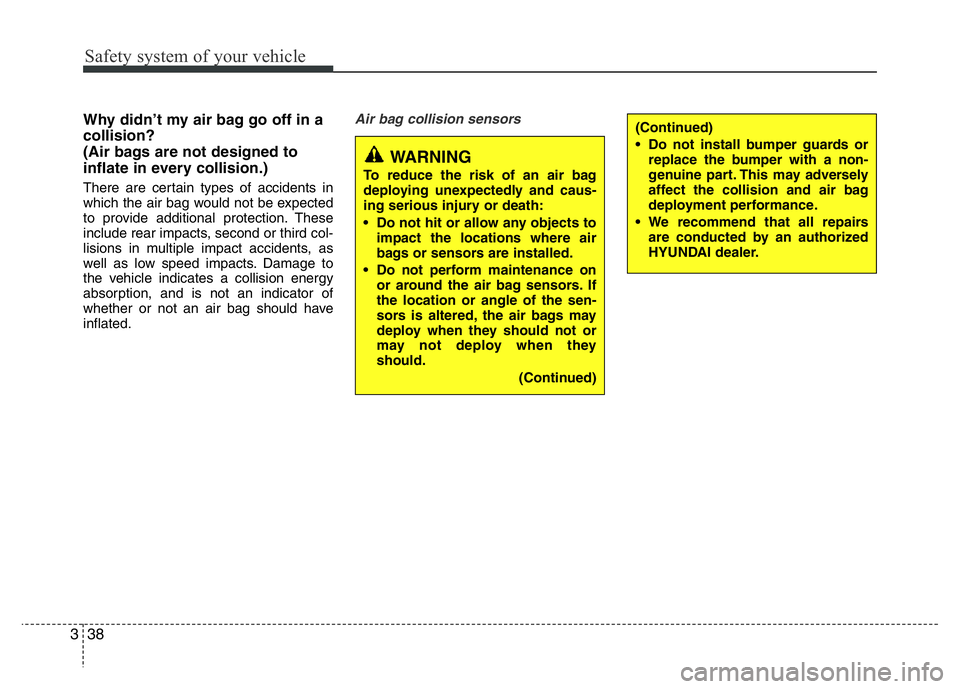
Safety system of your vehicle
38 3
Why didn’t my air bag go off in a
collision?
(Air bags are not designed to
inflate in every collision.)
There are certain types of accidents in
which the air bag would not be expected
to provide additional protection. These
include rear impacts, second or third col-
lisions in multiple impact accidents, as
well as low speed impacts. Damage to
the vehicle indicates a collision energy
absorption, and is not an indicator of
whether or not an air bag should have
inflated.
Air bag collision sensors
WARNING
To reduce the risk of an air bag
deploying unexpectedly and caus-
ing serious injury or death:
• Do not hit or allow any objects to
impact the locations where air
bags or sensors are installed.
• Do not perform maintenance on
or around the air bag sensors. If
the location or angle of the sen-
sors is altered, the air bags may
deploy when they should not or
may not deploy when they
should.
(Continued)
(Continued)
• Do not install bumper guards or
replace the bumper with a non-
genuine part. This may adversely
affect the collision and air bag
deployment performance.
• We recommend that all repairs
are conducted by an authorized
HYUNDAI dealer.
Page 55 of 343
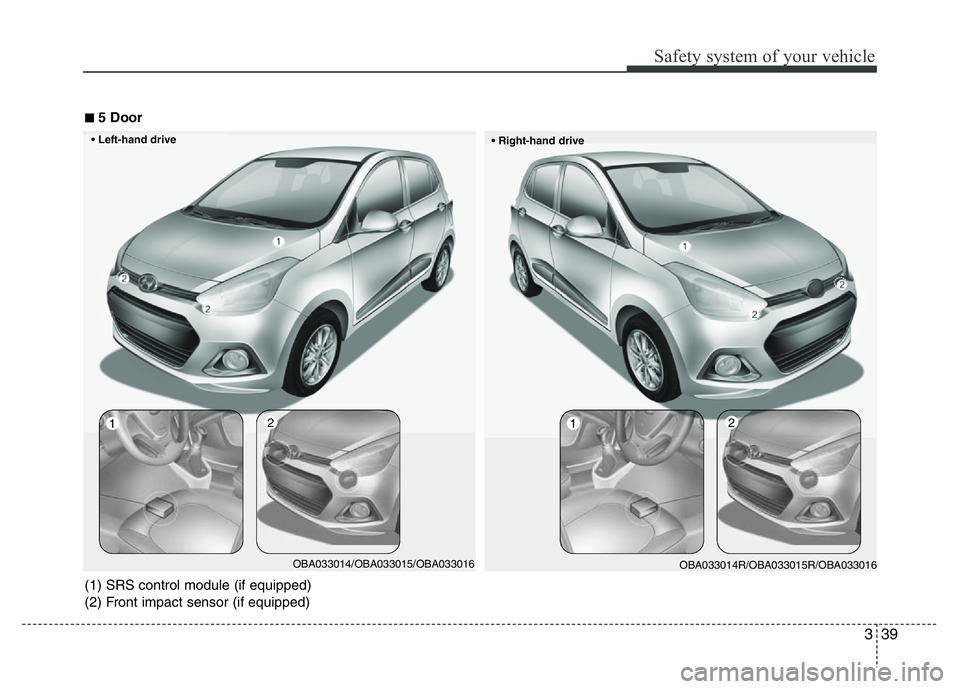
339
Safety system of your vehicle
12
OBA033014R/OBA033015R/OBA033016
12
OBA033014/OBA033015/OBA033016
■5 Door
• Right-hand drive • Left-hand drive
(1) SRS control module (if equipped)
(2) Front impact sensor (if equipped)
Page 56 of 343
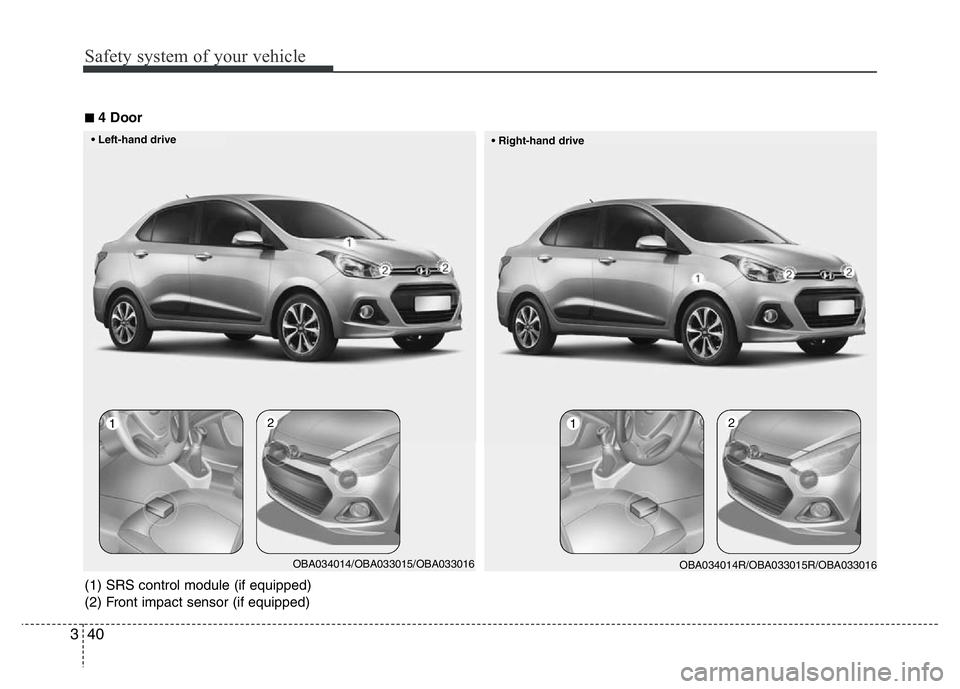
Safety system of your vehicle
40 3
12
OBA034014R/OBA033015R/OBA033016
12
OBA034014/OBA033015/OBA033016
■4 Door
• Right-hand drive • Left-hand drive
(1) SRS control module (if equipped)
(2) Front impact sensor (if equipped)
Page 57 of 343
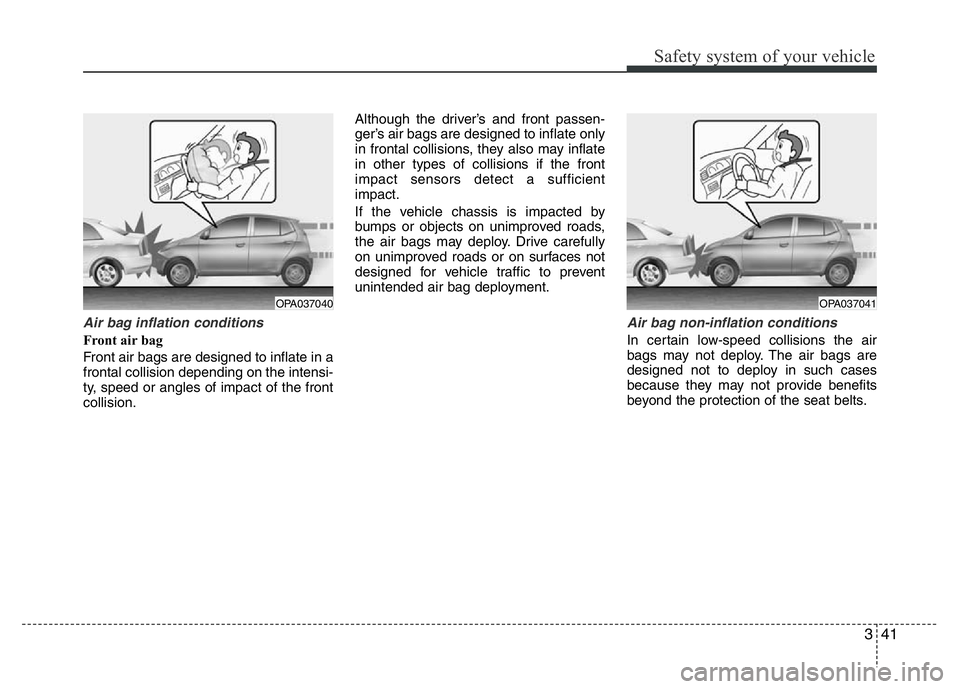
341
Safety system of your vehicle
Air bag inflation conditions
Front air bag
Front air bags are designed to inflate in a
frontal collision depending on the intensi-
ty, speed or angles of impact of the front
collision.Although the driver’s and front passen-
ger’s air bags are designed to inflate only
in frontal collisions, they also may inflate
in other types of collisions if the front
impact sensors detect a sufficient
impact.
If the vehicle chassis is impacted by
bumps or objects on unimproved roads,
the air bags may deploy. Drive carefully
on unimproved roads or on surfaces not
designed for vehicle traffic to prevent
unintended air bag deployment.
Air bag non-inflation conditions
In certain low-speed collisions the air
bags may not deploy. The air bags are
designed not to deploy in such cases
because they may not provide benefits
beyond the protection of the seat belts.
OPA037041OPA037040
Page 58 of 343
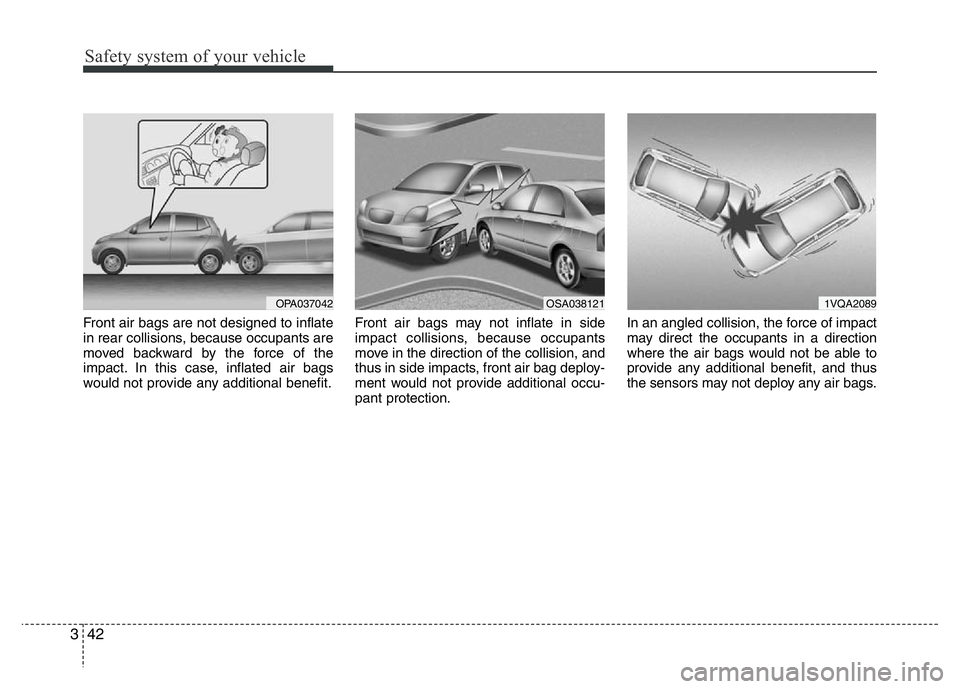
Safety system of your vehicle
42 3
Front air bags are not designed to inflate
in rear collisions, because occupants are
moved backward by the force of the
impact. In this case, inflated air bags
would not provide any additional benefit.Front air bags may not inflate in side
impact collisions, because occupants
move in the direction of the collision, and
thus in side impacts, front air bag deploy-
ment would not provide additional occu-
pant protection.In an angled collision, the force of impact
may direct the occupants in a direction
where the air bags would not be able to
provide any additional benefit, and thus
the sensors may not deploy any air bags.
1VQA2089OSA038121OPA037042
Page 59 of 343
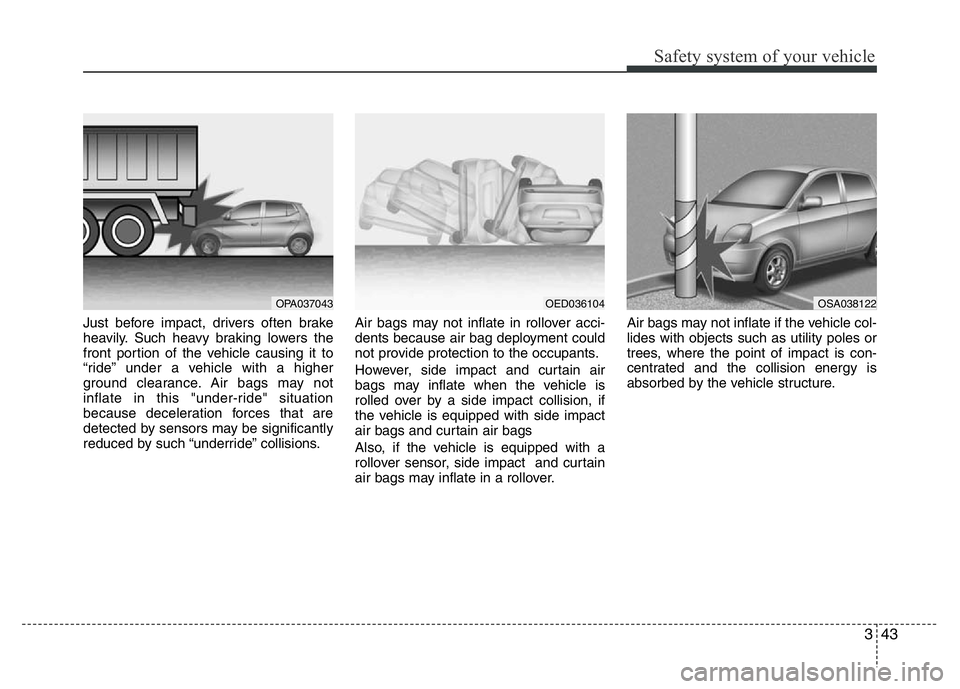
343
Safety system of your vehicle
Just before impact, drivers often brake
heavily. Such heavy braking lowers the
front portion of the vehicle causing it to
“ride” under a vehicle with a higher
ground clearance. Air bags may not
inflate in this "under-ride" situation
because deceleration forces that are
detected by sensors may be significantly
reduced by such “underride” collisions.Air bags may not inflate in rollover acci-
dents because air bag deployment could
not provide protection to the occupants.
However, side impact and curtain air
bags may inflate when the vehicle is
rolled over by a side impact collision, if
the vehicle is equipped with side impact
air bags and curtain air bags
Also, if the vehicle is equipped with a
rollover sensor, side impact and curtain
air bags may inflate in a rollover.Air bags may not inflate if the vehicle col-
lides with objects such as utility poles or
trees, where the point of impact is con-
centrated and the collision energy is
absorbed by the vehicle structure.
OPA037043OED036104OSA038122
Page 60 of 343
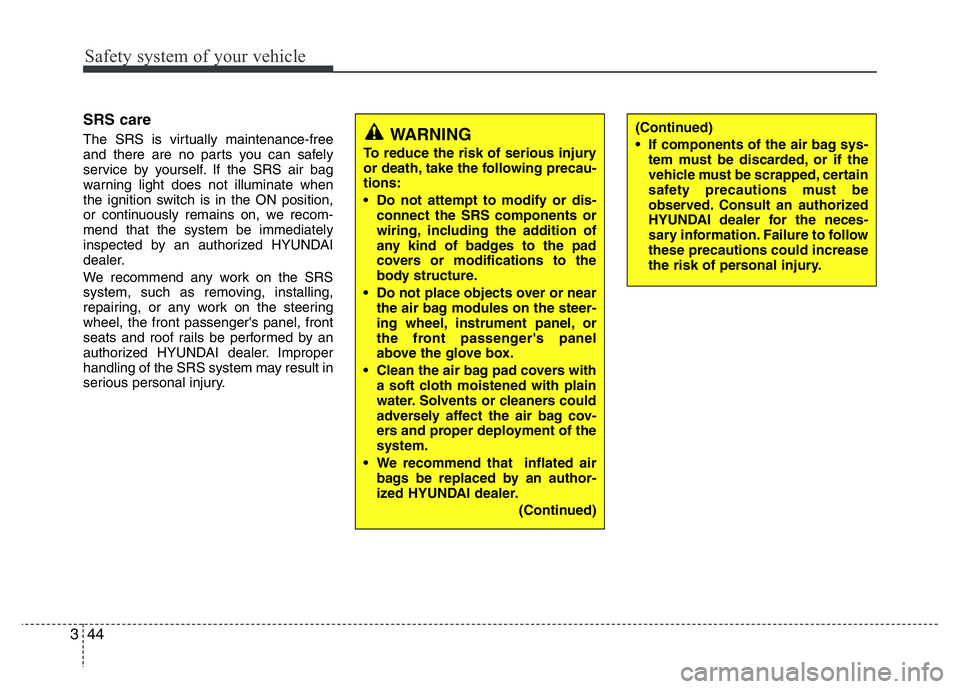
Safety system of your vehicle
44 3
SRS care
The SRS is virtually maintenance-free
and there are no parts you can safely
service by yourself. If the SRS air bag
warning light does not illuminate when
the ignition switch is in the ON position,
or continuously remains on, we recom-
mend that the system be immediately
inspected by an authorized HYUNDAI
dealer.
We recommend any work on the SRS
system, such as removing, installing,
repairing, or any work on the steering
wheel, the front passenger's panel, front
seats and roof rails be performed by an
authorized HYUNDAI dealer. Improper
handling of the SRS system may result in
serious personal injury.WARNING
To reduce the risk of serious injury
or death, take the following precau-
tions:
• Do not attempt to modify or dis-
connect the SRS components or
wiring, including the addition of
any kind of badges to the pad
covers or modifications to the
body structure.
• Do not place objects over or near
the air bag modules on the steer-
ing wheel, instrument panel, or
the front passenger's panel
above the glove box.
• Clean the air bag pad covers with
a soft cloth moistened with plain
water. Solvents or cleaners could
adversely affect the air bag cov-
ers and proper deployment of the
system.
• We recommend that inflated air
bags be replaced by an author-
ized HYUNDAI dealer.
(Continued)
(Continued)
• If components of the air bag sys-
tem must be discarded, or if the
vehicle must be scrapped, certain
safety precautions must be
observed. Consult an authorized
HYUNDAI dealer for the neces-
sary information. Failure to follow
these precautions could increase
the risk of personal injury.